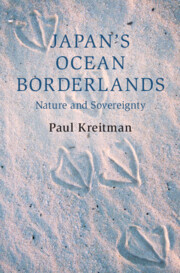Book contents
- Japan’s Ocean Borderlands
- Cambridge Oceanic Histories
- Japan’s Ocean Borderlands
- Copyright page
- Contents
- Maps
- Figures
- Acknowledgements
- Naming Conventions
- Maps
- Introduction
- 1 Bonins of Contention
- 2 The Race to Marcus Island
- 3 Bird and Sovereignty Conservation in the Northwest Hawaiian Islands, 1898–1911
- 4 Sand Dunes and Soldiers
- 5 Disaster
- 6 Resurrecting the Torishima Albatross
- 7 The Nature of the Senkaku Islands
- Epilogue
- Appendix Japanese Islands Abandoned, 1868–2013
- Select Bibliography
- Index
1 - Bonins of Contention
Extraterritorial Empire and Borderland Citizenship in the Nineteenth-Century Pacific
Published online by Cambridge University Press: 06 July 2023
- Japan’s Ocean Borderlands
- Cambridge Oceanic Histories
- Japan’s Ocean Borderlands
- Copyright page
- Contents
- Maps
- Figures
- Acknowledgements
- Naming Conventions
- Maps
- Introduction
- 1 Bonins of Contention
- 2 The Race to Marcus Island
- 3 Bird and Sovereignty Conservation in the Northwest Hawaiian Islands, 1898–1911
- 4 Sand Dunes and Soldiers
- 5 Disaster
- 6 Resurrecting the Torishima Albatross
- 7 The Nature of the Senkaku Islands
- Epilogue
- Appendix Japanese Islands Abandoned, 1868–2013
- Select Bibliography
- Index
Summary
The North Pacific in the mid-nineteenth century was an oceanic borderland zone shaped by whaling and other extractive industries, and characterised by the rapid circulation of animals, people, commodities and capital. It was also a thoroughly imperial space: while Japanese, Pacific Islanders and white ‘beachcombers’ all worked aboard whalers, only the latter could leverage their citizenship to secure extraterritorial protection from imperial powers.
The history of the Bonin (J: Ogasawara) Islands illustrates this well. Until 1830 the islands had only the most fleeting history of human habitation, yet by 1863 they had emerged as a vital provisioning hub for the whaling fleet, populated by Native Hawaiians, Pacific Islanders and Anglo beachcombers. When the Tokugawa government began colonising the islands, the beachcombers pointedly refused to naturalise as Japanese citizens, and secured diplomatic backing from their respective consulates in Tokyo. In doing so they frustrated Japanese attempts to assert territorial sovereignty over the Bonins for a generation.
Keywords
- Type
- Chapter
- Information
- Japan's Ocean BorderlandsNature and Sovereignty, pp. 21 - 53Publisher: Cambridge University PressPrint publication year: 2023



